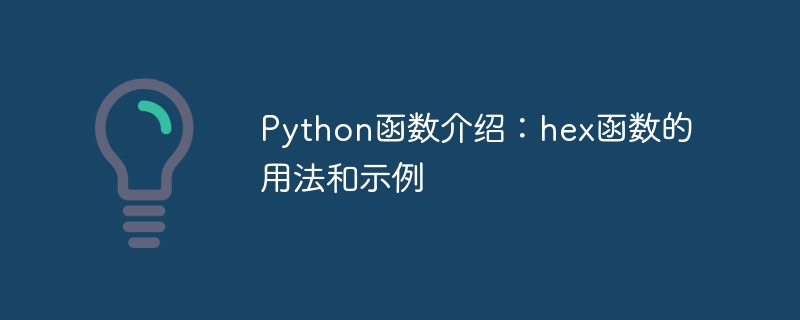Home >Backend Development >Python Tutorial >Introduction to Python functions: usage and examples of hex function
Introduction to Python functions: usage and examples of hex function
- 王林Original
- 2023-11-04 14:18:423311browse

Introduction to Python functions: Usage and examples of hex function
Python is a very powerful and widely used programming language, which provides many built-in functions to facilitate us Implement various operations. Among them, the hex function is a very useful function, which can convert an integer into a string represented by hexadecimal. This article will introduce the usage of hex function and give some sample code.
The usage of the hex function is very simple. It only accepts an integer as a parameter and returns a corresponding hexadecimal string. The following is the basic syntax of the hex function:
hex(number)
where number is the integer that needs to be converted. Here are some examples of using the hex function:
Example one:
decimal_number = 123
hex_number = hex(decimal_number)
print("The hexadecimal representation of", decimal_number, "is", hex_number)Output:
The hexadecimal representation of 123 is 0x7b
Example two:
decimal_number = 255
hex_number = hex(decimal_number)
print("The hexadecimal representation of", decimal_number, "is", hex_number)Output:
The hexadecimal representation of 255 is 0xff
Example 3:
decimal_number = 16
hex_number = hex(decimal_number)
print("The hexadecimal representation of", decimal_number, "is", hex_number)Output:
The hexadecimal representation of 16 is 0x10
In example 1, we converted the decimal number 123 into hexadecimal representation and obtained the string "0x7b". Similarly, in Example 2 and Example 3, we converted the decimal numbers 255 and 16 into hexadecimal representation respectively, and obtained the strings "0xff" and "0x10".
It should be noted that the hexadecimal string returned by the hex function will always start with "0x". This prefix is used to indicate that the string is a hexadecimal number.
In addition to integers, the hex function can also accept other types of parameters. For non-integer types such as floating point numbers, Boolean values, and strings, the hex function will first convert them into integers, and then convert the integers into hexadecimal strings.
Example 4:
floating_point_number = 3.14
hex_number = hex(floating_point_number)
print("The hexadecimal representation of", floating_point_number, "is", hex_number)Output:
The hexadecimal representation of 3.14 is 0x3
In Example 4, we pass the floating point number 3.14 to the hex function. Since floating point numbers cannot be directly converted into integers, so The hex function will first convert it to the nearest integer 3, and then convert 3 to the hexadecimal string "0x3".
In general, the hex function is a very practical function in Python, which can easily convert integers into hexadecimal strings. Whether in fields such as data processing, network communications, cryptography, or in writing applications such as games and graphical interfaces, the hex function plays an important role.
I hope that through the introduction of this article, readers can become more familiar with and master the use of the hex function, so as to better apply it to actual programming work. Happy programming everyone!
The above is the detailed content of Introduction to Python functions: usage and examples of hex function. For more information, please follow other related articles on the PHP Chinese website!

